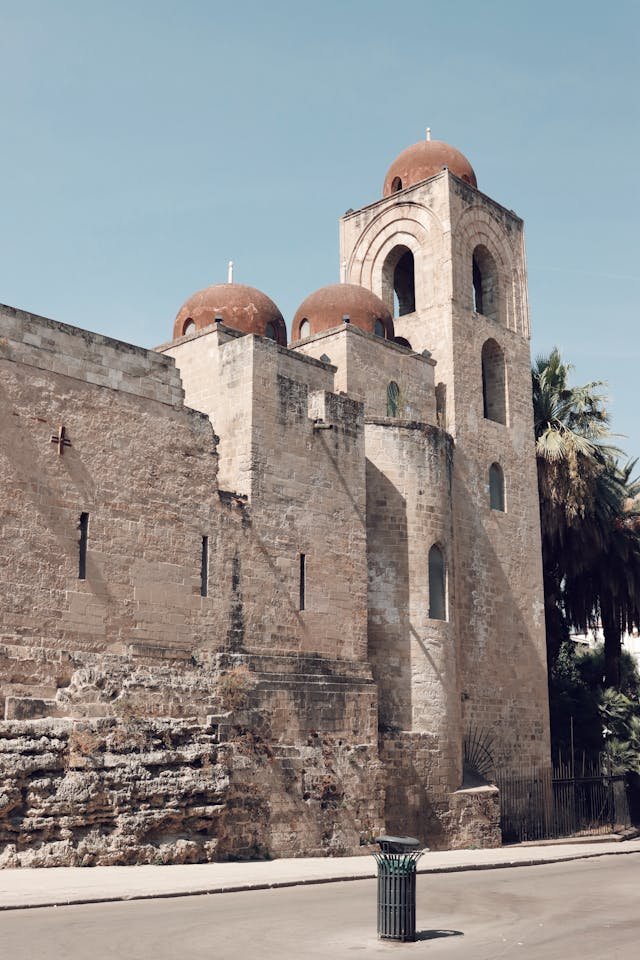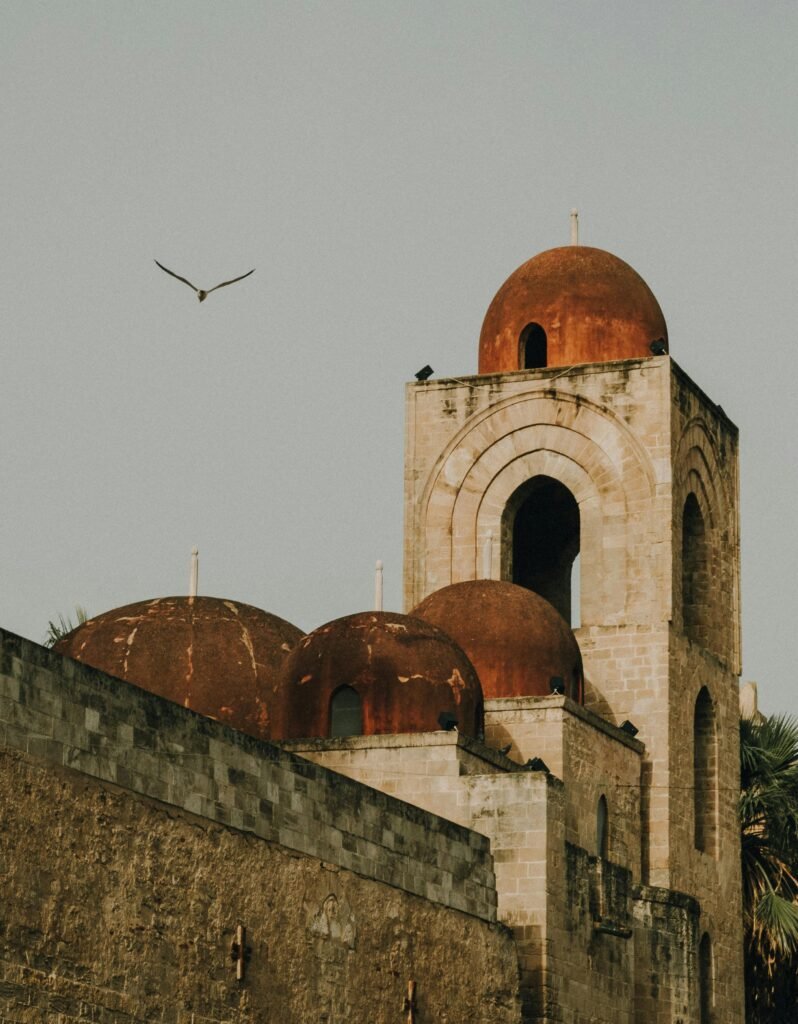During my first visit to Palermo back in 2018, I made the rookie mistake of just snapping photos from street level.
Boy, was I missing out! It wasn’t until a local guide named Giuseppe practically dragged me up to a restricted viewing area that I realized these weren’t just pretty architectural features.
These red domes are basically time capsules holding centuries of stories, mysteries, and cultural secrets that most tourists never discover. It is one of the best things to see in Palermo.
We’re talking about hidden chambers, forgotten rituals, and archaeological findings that completely flip the script on what we thought we knew about medieval Sicily.
From underground tunnels to secret religious ceremonies, the red domes of Palermo conceal a world of intrigue that will completely change how you see this incredible city.
The Origins of Palermo’s Iconic Red Domes

I used to think all those red domes were just a quirky architectural choice, but man, was I wrong!
The story behind these stunning structures is way more complex and fascinating than I ever imagined.
It all started during the Arab-Norman period, roughly between the 9th and 12th centuries, when Sicily became this incredible melting pot of cultures.
Here’s what blew my mind during my research: the red color isn’t just for show.
Those terracotta tiles were actually the most practical choice for the Mediterranean climate.
The clay used in these tiles comes from specific quarries in the hills surrounding Palermo, and it’s got these unique properties that help regulate temperature inside the buildings. Smart, right?
But here’s where it gets really interesting. The dome construction techniques used in Palermo are this amazing fusion of Islamic engineering and Norman architectural preferences.
The engineering behind these domes is absolutely mind-blowing.
They used a technique called “squinch construction” that allows a circular dome to sit perfectly on a square base.
What really gets me excited is how each dome tells a different story.
The oldest ones, dating back to around 1130, have slightly different proportions and construction methods than the later ones.
You can literally see the evolution of architectural techniques just by walking around the city and really looking at these structures.
Hidden Chambers and Secret Spaces Within the Domes
I remember the exact moment I learned about the hidden chambers.
I was touring San Giovanni degli Eremiti with a group of architecture students, feeling pretty smug about my knowledge, when our guide casually mentioned that we were standing directly above a series of underground rooms that hadn’t been fully mapped yet.
My jaw literally dropped.
Turns out, many of Palermo’s red domes are connected by a network of underground tunnels that most people don’t even know exist.
During World War II, locals used some of these spaces as air raid shelters, but their original purposes go way back to medieval times.
I managed to get access to one of these tunnel systems last year through a special archaeological tour, and let me tell you, it was like stepping into a different world.
The most incredible discovery happened just three years ago beneath the Cathedral’s main dome.
Construction workers renovating the foundation stumbled upon a sealed chamber containing what appeared to be merchant storage rooms from the 13th century.
Inside, they found ceramic fragments, ancient coins, and even some preserved wooden crates with Arabic inscriptions.
But here’s the kicker – some of these hidden spaces seem to have been used as secret meeting places for medieval guilds.
I’ve seen evidence of carved symbols on the walls that match guild markings found in other parts of Europe.
It’s like these domes were hiding an entire shadow society right under everyone’s noses!
The Mysterious Symbols and Markings You’ve Never Noticed
The Islamic geometric patterns are absolutely everywhere once you start recognizing them.
There’s this one dome near the Quattro Canti where you can spot an intricate eight-pointed star pattern that’s actually a classic Islamic symbol representing rebirth and regeneration.
But here’s what’s fascinating – right next to it, there’s a Christian cross worked into the design so seamlessly that it almost looks intentional.
Actually, it probably was intentional.
The more I researched this, the more I realized that the builders were deliberately creating these hybrid symbol systems that could be interpreted by different religious communities in their own ways. It’s like architectural diplomacy!
I spent an entire afternoon with a magnifying glass (yeah, I’m that guy) examining the markings on the dome of Santa Maria dell’Ammiraglio, and I found what looked like Masonic symbols from much later periods.
This suggests that these buildings were modified and re-marked over the centuries by different groups who used them for various purposes.
The trade guild symbols are probably my favorite discovery.
Each guild had its own mark – the stonemasons, the metalworkers, the cloth merchants – and you can find these carved into various parts of the dome structures.
It’s like they were signing their work or marking their territory. Some of these marks are so small you need binoculars to spot them from ground level.
Religious and Cultural Secrets of the Red Dome Churches
This is where my understanding of Palermo’s religious landscape completely shifted.
I grew up thinking that religious buildings were pretty straightforward – you build a church, you worship there, end of story.
But the red dome churches of Palermo are operating on a completely different level of complexity.
The blending of religious traditions in these spaces is absolutely mind-boggling.
I discovered that some of the churches with red domes were built on top of existing Islamic prayer halls, and instead of completely destroying the original structures, the Norman builders incorporated Islamic architectural elements into their Christian designs.
It’s like religious architecture fusion cuisine!
During one particularly memorable visit to the Cappella Palatina, I noticed that the mihrab (the Islamic prayer niche) was still visible, but it had been converted into a Christian altar space.
The guide explained that this wasn’t unusual – it was actually a deliberate strategy to help ease the transition for the local population who had been practicing Islam for centuries.
But here’s where it gets really interesting: some of these dome spaces seem to have been used for interfaith ceremonies.
I found references in 14th-century documents to “ceremonies of unity” that brought together Christian, Islamic, and Jewish community leaders under specific red domes.
Can you imagine? This was happening hundreds of years before anyone was talking about religious tolerance!
The acoustics inside these domed spaces create this incredible sound experience that was definitely intentional.
I also learned about some pretty wild legends associated with specific domes.
There’s one church where locals swear that prayers made under the central red dome are more likely to be answered.
Scientifically ridiculous? Absolutely. But the faith and tradition behind it? That’s real cultural heritage right there.
Famous Red Domes of Palermo You Can Visit Today
San Giovanni degli Eremiti is obviously the most famous, with those five distinctive red domes that look like they’re straight out of Arabian Nights.
But here’s what most guidebooks don’t tell you: visit right after they open at 9 AM or about an hour before closing.
The Cathedral of Palermo is where things get really exciting, especially if you can arrange a guided tour that includes access to the dome chambers.
But my personal favorite discovery is the Chiesa di San Cataldo, which has three red domes that most tourists walk right past.
The interior is incredibly well-preserved, and because it’s less crowded, you can really take your time examining the architectural details.
Plus, the acoustics are amazing – if you’re there alone, try whispering and listen to how your voice carries.
For photography enthusiasts, the best light happens about 45 minutes before sunset when the red tiles really start to glow.
How to Explore Palermo’s Red Domes Like a Local
After years of trial and error, I’ve figured out the best strategies for really experiencing these incredible structures instead of just looking at them from a distance like most tourists do.
First, forget the big tour groups. I’ve found that the best experiences come from smaller, specialized tours led by local historians or archaeology students. These guides know which doors to knock on, which viewing angles reveal hidden details, and which times of day offer the best access to restricted areas.
Photography-wise, bring a good zoom lens and don’t be afraid to get creative with your angles. Some of my favorite dome shots were taken from unexpected locations – rooftop restaurants, hotel balconies, even from the windows of public buses. The key is thinking three-dimensionally about how these domes relate to the cityscape around them.
Here’s a local secret: many Palermo residents have incredible stories about these domes that you’ll never hear on official tours. I’ve learned some of my most fascinating dome facts from conversations in neighborhood cafés and local markets. Don’t be shy about asking questions – most locals are proud of their architectural heritage and love sharing what they know.
The best times for exploration are early morning and late afternoon when the tourist crowds are thinner and the light is more dramatic. I’ve also discovered that visiting during religious festivals can provide access to areas that are normally closed to the public.
Respectful exploration is crucial. These are active religious sites and protected historical monuments. Always ask permission before photographing interiors, don’t touch ancient surfaces, and be mindful of ongoing religious services. I’ve seen too many tourists get escorted out because they forgot these basic courtesies.
If you’re really serious about dome exploration, consider timing your visit to coincide with Palermo’s archaeological open house events, which happen several times a year. These events provide access to sites and areas that are normally completely off-limits to the public.



